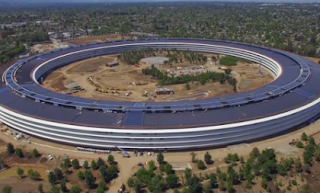In September 2014, the cleared land once home to Hewlett-Packard was little more than a field of dust. Today, as the first of 12,000 employees prepare to move in, it is the location of Apple's gleaming new headquarters.
Officially called Apple Park but still better known for its "spaceship" nickname given for its futuristic design, a new drone video posted in recent days by Matthew Roberts shows the sprawling, 176-acre Cupertino campus in the final stages of construction.
While at first glance it looks pretty much complete, closer inspection reveals work continuing in a number of areas around the site, including at the Steve Jobs Theater, the company’s subterranean 1,000-seat auditorium featuring a 20-foot-tall glass cylinder, 165 feet in diameter, supporting a metallic carbon-fiber roof.
Apple employees are expected any day now to begin transferring to the distinctive, doughnut-shaped main building, which is wrapped in the world’s largest segments of curved glass and topped off with a covering of solar panels that will help power the campus. The process of moving all 12,000 workers to the new site is expected to take up to six months.
Besides the main building and theater, the tech giant's new base includes a 100,000-square-foot fitness center to keep Apple’s team in top shape, a research and development facility where Jony Ive and co. will endeavor to cook up the company’s next big success, and expansive landscaped parklands.
Notably, Apple claims its new HQ is the world's largest naturally ventilated building and is therefore not expected to require heating or air conditioning for nine months of the year.
"Steve's vision for Apple stretched far beyond his time with us," Apple boss Tim Cook said in a statement earlier this year. "He intended Apple Park to be the home of innovation for generations to come. The workspaces and parklands are designed to inspire our team as well as benefit the environment. We’ve achieved one of the most energy-efficient buildings in the world and the campus will run entirely on renewable energy."
Fans of the company, or those with an interest in stunning modern architecture, are invited to drop by Apple Park's visitors center, which, as everyone should expect, includes an Apple Store as well as a cafe.
The design of Apple Park is the work of acclaimed architect Norman Foster, though it was the former Apple boss and co-founder Steve Jobs who drove the ambitious project forward in the years and months leading up to his death in 2011.
Officially called Apple Park but still better known for its "spaceship" nickname given for its futuristic design, a new drone video posted in recent days by Matthew Roberts shows the sprawling, 176-acre Cupertino campus in the final stages of construction.
While at first glance it looks pretty much complete, closer inspection reveals work continuing in a number of areas around the site, including at the Steve Jobs Theater, the company’s subterranean 1,000-seat auditorium featuring a 20-foot-tall glass cylinder, 165 feet in diameter, supporting a metallic carbon-fiber roof.
Apple employees are expected any day now to begin transferring to the distinctive, doughnut-shaped main building, which is wrapped in the world’s largest segments of curved glass and topped off with a covering of solar panels that will help power the campus. The process of moving all 12,000 workers to the new site is expected to take up to six months.
Besides the main building and theater, the tech giant's new base includes a 100,000-square-foot fitness center to keep Apple’s team in top shape, a research and development facility where Jony Ive and co. will endeavor to cook up the company’s next big success, and expansive landscaped parklands.
Notably, Apple claims its new HQ is the world's largest naturally ventilated building and is therefore not expected to require heating or air conditioning for nine months of the year.
"Steve's vision for Apple stretched far beyond his time with us," Apple boss Tim Cook said in a statement earlier this year. "He intended Apple Park to be the home of innovation for generations to come. The workspaces and parklands are designed to inspire our team as well as benefit the environment. We’ve achieved one of the most energy-efficient buildings in the world and the campus will run entirely on renewable energy."
Fans of the company, or those with an interest in stunning modern architecture, are invited to drop by Apple Park's visitors center, which, as everyone should expect, includes an Apple Store as well as a cafe.
The design of Apple Park is the work of acclaimed architect Norman Foster, though it was the former Apple boss and co-founder Steve Jobs who drove the ambitious project forward in the years and months leading up to his death in 2011.


















0 comments
Post a Comment